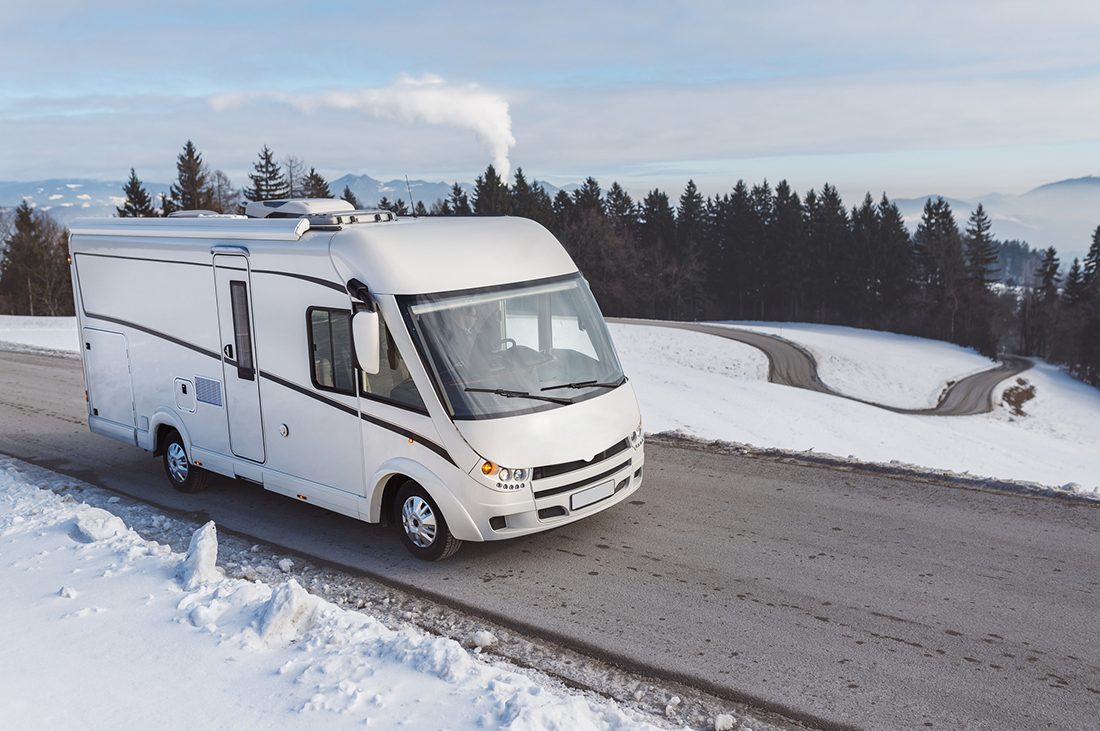RV travel doesn’t have to stop with the arrival of winter, but there are considerations to keep in mind when driving in cold weather.
The best advice for driving in bad winter weather is not to drive at all, if you can avoid it. Don’t go out until the snow plows and sanding trucks have had a chance to do their work, and allow yourself extra time to reach your destination. If you must drive in snowy conditions, make sure you and your RV are prepared, and that you know how to handle winter road conditions.
Prepare an emergency survival kit containing a cell phone, warm blankets, gloves, salt or sand, LED flashlights, first aid kit, NOAA weather radio, road flares, bottled water, and non-perishable food. Inspect tires, use tires designed to operate in snow and ice, and keep tires inflated to proper levels. Inspect wipers and wiper blades. Make sure you have a snowbrush and ice scraper in to remove snow and ice.
There are no secrets when it comes to winter driving. If there is ice on the road, it is dangerous.
If you’re driving on ice, you may not know it until you need to stop. It doesn’t matter if you’re driving a 4-wheel drive, a fifth-wheel or travel trailer, or a motorhome: brakes are the great equalizer.
Ice on your windshield means ice on the road. The ice doesn’t have to be packed up on the roadway to be dangerous—a thin sheet of ice can develop quickly into a thick problem.
Keep an eye on the temperature. Water freezes at 32 degrees. The roadways tend to be slightly warmer than the air temperature, but once you’re down that low in temperature, you need to be wary.
Look for spray coming up from other vehicles. If spray is coming off the tires, it’s likely that the roads are wet (as opposed to ice covered), but keep in mind that a short stretch of road with ice on it can be just as dangerous as an ice-packed roadway.
Do not follow too close.
Watch for warning signs. If there are vehicles spun out in the median or shoulder, the roads are bad. If you start seeing big semis spun out, it’s time to get your RV off the road. It’s not worth endangering your life and the life of your family. If you can’t find a nearby RV park or campground locate the nearest truck stop or Walmart to overnight.
Be sure to keep your fuel tanks full so you won’t run out.
Prior to departure check weather conditions along your intended travel route. When traveling, listen to local radio stations for the forecast and update on current weather and road conditions.
Any vehicles traveling through mountain passes and northern states and provinces may be required to carry a set of tire chains available in case of a snow or ice storm. Practice putting them on while it’s warm and dry.
Drive an RV slower than you would drive a car—especially in bad weather. Leave extra room between your RV and the vehicle in front of you. RVs require even more time and room to stop in bad weather.
Use extra caution when traveling across bridges and overpasses. They freeze before the road.
Vision can be hindered when driving during a bright, sunny day and the surroundings are snow covered. Wear sunglasses to reduce glare and improve vision.
